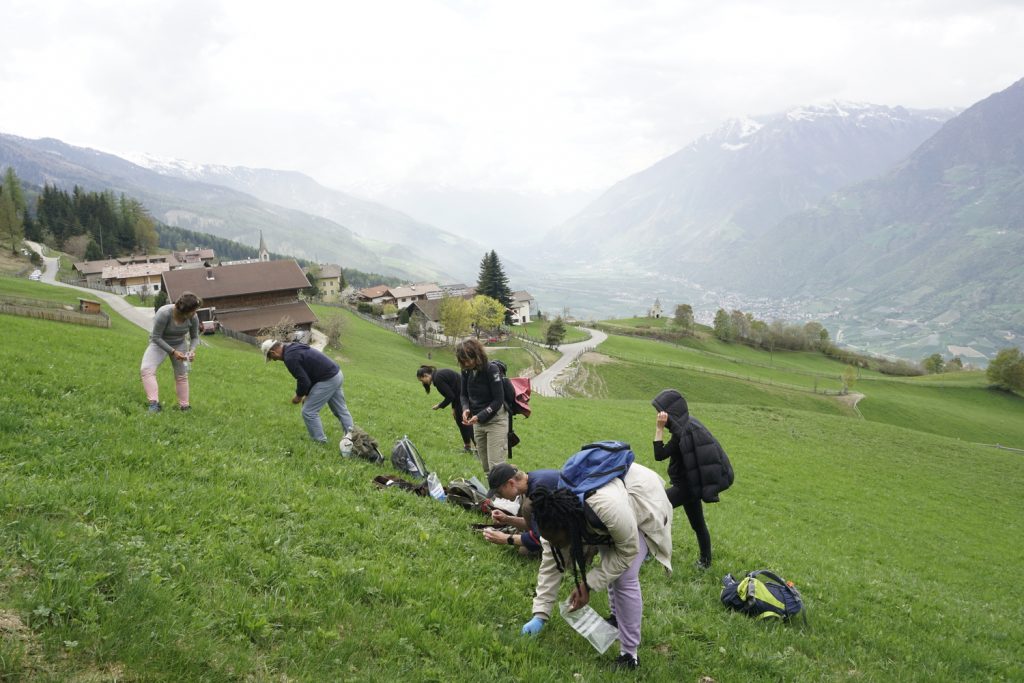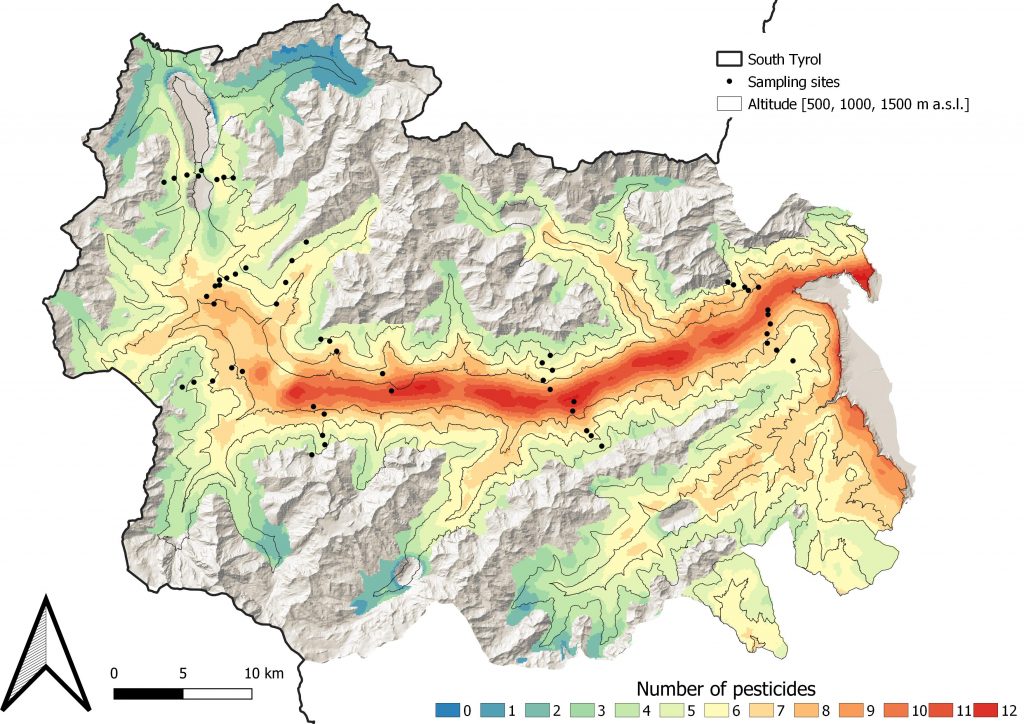In this blog post Carsten Brühl is explaining the background of this first landscape level terrestrial pesticide exposure study.
The Venosta or Vinschgau Valley is located in South Tyrol, primarily associated with mountains and nature. In this region in the North of Italy, more than 7,000 apple growers produce ten percent of all European apples. Conventional apple cultivation relies primarily on synthetic pesticides, which are applied by fan-assisted sprayers: insecticides to combat pests such as the codling moth and fungicides against fungal diseases that cause scab on the fruit. This results in a high level of drift into the environment, especially in windy conditions.For a long time, even experts assumed that the synthetic pesticides essentially remained in the apple orchard where they were applied and that they could only be found in the immediate vicinity. However, this assumption is based on outdated and less sensitive measurement methods and the fact that pesticides away from the production areas were simply not recorded, explains Carsten. With today’s modern analytical methods, up to one hundred current use pesticides can be measured simultaneously, even in low concentrations. Other studies show that pesticides spread well beyond agricultural land and expose insects in nature reserves or can be found in the ambient air far away from agriculture. In the Venosta Valley, a decline in butterflies on mountain meadows was observed several years ago. Experts suspected a connection with the use of pesticides in the valley, but there are hardly any studies on the question of how far current use pesticides are actually transported and how long they remain in the soil and plants. This prompted Carsten and Johann Zaller from BOKU, Vienna to investigate the distribution of pesticides in the environment in the Venosta Valley.
Measuring pesticide distribution on a landscape scale for the first time
“From an ecotoxicological perspective, the Venosta Valley is particularly interesting, as the valley is characterized by highly intensive cultivation with many pesticides and the mountains are home to sensitive alpine ecosystems, that are in some cases also strictly protected,” explains Carsten, “this is a very steep land use gradient”. Our team from the lab at the RPTU in Landau, Nina Engelhard who took this project up as a master thesis and a group of students in the laboratory and field course “Methods in Ecotoxicology” in the Master program “Environmental Pollution Management – Ecotoxicology”, went to Mals and met with Johann Zaller and Koen Hertoge, who lives there, in May 2022. The entire group was trained on the first day on how to sample along an altitudinal transect. Sounds very technical but it means mainly one thing: you have to climb a mountain and take samples at regular intervals, approximately every 300 m in altitude. We established a total of eleven altitudinal transects along the entire valley axis, from the valley floor at 500 meters above sea level to mountain peaks above 2,300 meters. At each of the 53 preselected sampling sites plant material was collected and soil samples were taken in a standarized way. On day two we sampled transects in two groups and on the next days we split up into smaller teams as now the procedure was well established. This allowed us to sample all sites within four days – a feat that would not be possible for a single person. So, there was a lot of fresh air each day and after hiking a great meal was waiting in the Hotel Greif for us, prepared with love by the Sagmeister family. Thanks again!



The subsequent pesticide analysis in Landau showed that although the number of pesticides decreases overall at higher altitudes and with distance to the apple orchards. However, we still detected several substances in mixtures in the soil and vegetation, even in the upper Venosta Valley with hardly any apple cultivation. “We found the substances in remote mountain valleys, on the peaks, and in national parks. They have no place there,” emphasizes Carsten. Due to the sometimes strong valley winds and the thermal updrafts in the Venosta Valley, the substances spread further than one might assume based on their physical-chemical properties. Even at the low concentrations measured, pesticides can lead to sublethal effects on organisms. For butterflies, for example, this could mean a reduction in egg laying, which then leads to a population reduction. There was only one place where we found no pesticide substances in the vegetation – interestingly, there were also a lot of butterflies in that place.
Almost 30 pesticides detected
In our study, we recorded a total of 27 different pesticides in the environment. However, we carried out our measurements at the beginning of May and further pesticides are used during the growing season up to apple harvest. On average, almost 40 pesticide applications are common during the season. This means that more complex mixtures with several substances and recurring higher concentrations are likely. In almost half of all soil and plant samples, we were able to measure the insecticide methoxyfenozide, which has no longer been authorized in Germany since 2016 due to its harmfulness to the environment. Little is known about how chronic exposure to pesticides with mixtures in low concentrations affects the environment, and about the possible interaction of different substances. In the environmental risk assessment as part of the European authorization procedure, mixtures are not evaluated, but the substances are considered individually. “This has nothing to do with the reality of applications in the field or in the orchard and their fate in the environment,” says Carsten.


Modelling pesticide exposure
The unique dataset also enabled a comprehensive prediction of pesticide mixtures and their concentrations across the Venosta Valley, covering ca. 1,200 km². As such, the diverse contamination of soils and vegetation by multiple pesticides became visible even in remote and alpine regions. For instance, even in areas up to 1,500 m a.s.l. complex mixtures of pesticides (up to 8 substances) can be expected with high confidence. The approach leveraged geospatial data describing various land-use and land-cover factors to predict these non-target ecosystem contaminations with high accuracies (R² > 67%). “However, it is important to highlight that the model approach only considered pesticides for which actual measurements were available, thus the true complexity of pesticides in remote areas of the Vinschgau valley is likely to be higher” explains Jakob Wolfram.

We are concerned about the widespread pesticide contamination in the soil and plants and that even national parks, which were actually set up to protect endangered plants and animals, are exposed. “The concentrations we found were not high, but it has been proven that pesticides affect soil life even at very low concentrations,” explains soil expert Johann Zaller. In addition, we always found a cocktail of different pesticides, the effects of which may be amplified. “The results also show that the technique of pesticide application in apple cultivation is in great need of improvement, otherwise so many pesticides would not be found away from the apple orchards,” Johann is convinced. It is also uneconomical if the pesticides are not applied specifically to the target organisms.
“We know from previous studies that children’s playgrounds near apple orchards are contaminated with pesticides. In some cases, even throughout the year,” says co-author and pesticide critic Koen Hertoge, who lives in the Venosta Valley. “The current results show a new dimension to the problem, as even remote areas are contaminated with pesticides. Measures to protect nature and the health of the population are absolutely necessary and the new provincial government is now called upon to act.”
Promoting functional biodiversity as an alternative to pesticide use
Possible measures would be to reduce or even ban the use of pesticides, at least the substances detected in remote areas, the researchers conclude from their findings. In return, it is important to promote management practices that also encourage beneficial insect-pest interactions, the so-called functional biodiversity in the apple orchard and in the surrounding area. This means, for example, increasing the semi-natural and flower-rich grasslands in the landscape that provide a habitat also for the antagonists of apple pests. In addition, systematic pesticide monitoring should be introduced that includes measurements at various locations throughout the year to estimate the year-round pesticide input.
The responsibility for reducing the use of pesticides lies not only with the apple growers but also with the large supermarket chains: they could promote the acceptance of apples that do not look quite so perfect. We, consumers, could make a choice and see the brown spots on the outside of an apple as something that goes together with a lower pesticide impact on the environment. The fact that people are critical of the use of pesticides was demonstrated in 2014 by a referendum in the market town of Malles/Mals in the Upper Venosta Valley, where the majority voted against conventional apple cultivation.
Carsten Brühl concludes from the observed spread throughout the landscape: “We need regions where plants and animals are not contaminated with these bioactive substances. A reduction in pesticides – including large areas without any synthetic pesticide use – and the simultaneous expansion of organic farming is urgently needed to reduce landscape pollution. Our results show that it is necessary to act now as we unfortunately do not have more time.”
The Study
Carsten A. Brühl, Nina Engelhard, Nikita Bakanov, Jakob Wolfram, Koen Hertoge, Johann G. Zaller. 2024. Widespread contamination of soils and vegetation with Current Use Pesticide residues along altitudinal gradients in a European Alpine valley. Communications Earth & Environment (Nature Journal), Volume 5.
The study can be found here.
